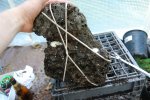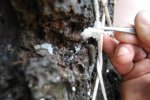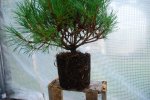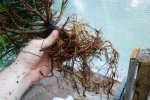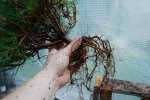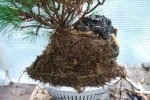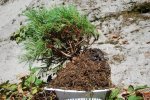brewmeister83
Chumono
Back in April of '14, I PM'd Vance and asked him if, to his knowledge, he knew of anyone who had tried an exposed root Mugo. He replied that he didn't know of anyone in the U.S. who took Mugo serious enough to try such a thing - so no. We bantered back and forth for a couple messages, and when I mentioned I had purchased several small (3-5 yr old) pumilio that spring, he said it might be possible to bare root and manipulate the plants if they’re that young and strong. Challenge accepted in my book...
For the past year I've been feeding and caring for these little pines to make them as healthy and strong as I can, so I figured this year I'd start with one today to see how it reacts to a little abusive manipulation... Here's the results for the first one:
$7 - 1/2 gallon pot from Lowe's last spring - if it dies, all I wasted was a little of my time and $5 worth of fertilizer...

Recently I've become fascinated with root-over-rock pines, and as it so happens I went and collected some rocks last week that might fit the bill. Well, not really rocks - You see, where I live is an area where 200 years ago people smelted pig iron for export and refinement elsewhere - and one can find the "junk" from the smelting process (known as slag) in many, many rivers and river banks around here. I had one rock that was big enough to accommodate this pine, but it was in two pieces... Nothing a little waterproof epoxy glue can't fix!

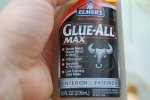

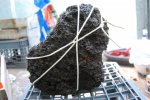
While I was waiting for the glue to finish curing, I figured I'd start by cleaning out the pine that I was going to pair up with this rock.

Classic example of how fertilizing frequency affects needle length on pines... Tiny brown needles stuck to my fingers are third year's growth (from before I bought it), then you can see the difference between last years growth (where I used a liquid fertilizer 3 time during the growing season) and this year's growth at the tip (fertilized every week since taken out of the cold-frame in spring). Judging by the differences in length, I'm guessing the nursery that raised these only did spring/fall applications of fertilizer...
More to follow...
For the past year I've been feeding and caring for these little pines to make them as healthy and strong as I can, so I figured this year I'd start with one today to see how it reacts to a little abusive manipulation... Here's the results for the first one:
$7 - 1/2 gallon pot from Lowe's last spring - if it dies, all I wasted was a little of my time and $5 worth of fertilizer...

Recently I've become fascinated with root-over-rock pines, and as it so happens I went and collected some rocks last week that might fit the bill. Well, not really rocks - You see, where I live is an area where 200 years ago people smelted pig iron for export and refinement elsewhere - and one can find the "junk" from the smelting process (known as slag) in many, many rivers and river banks around here. I had one rock that was big enough to accommodate this pine, but it was in two pieces... Nothing a little waterproof epoxy glue can't fix!




While I was waiting for the glue to finish curing, I figured I'd start by cleaning out the pine that I was going to pair up with this rock.

Classic example of how fertilizing frequency affects needle length on pines... Tiny brown needles stuck to my fingers are third year's growth (from before I bought it), then you can see the difference between last years growth (where I used a liquid fertilizer 3 time during the growing season) and this year's growth at the tip (fertilized every week since taken out of the cold-frame in spring). Judging by the differences in length, I'm guessing the nursery that raised these only did spring/fall applications of fertilizer...
More to follow...
Last edited:

